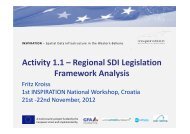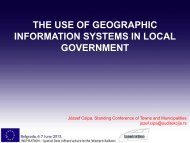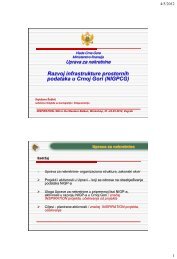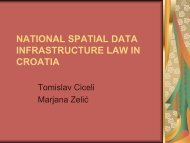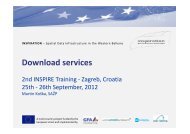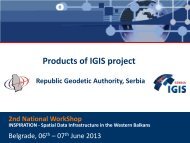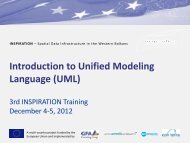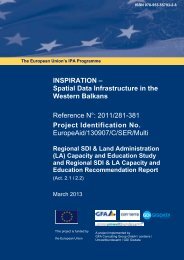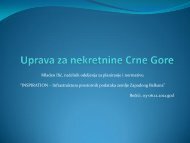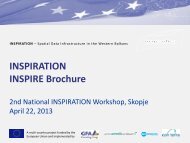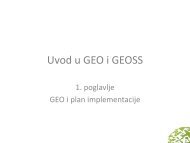MOVE - Moderation and Visualization for Group ... - INSPIRATION
MOVE - Moderation and Visualization for Group ... - INSPIRATION
MOVE - Moderation and Visualization for Group ... - INSPIRATION
You also want an ePaper? Increase the reach of your titles
YUMPU automatically turns print PDFs into web optimized ePapers that Google loves.
Of course, there are numerous media <strong>and</strong><br />
communication channels <strong>for</strong> visual aids: visual<br />
or audio-visual, still or moving pictures, two- or<br />
three-dimensional, permanent or non-permanent<br />
in terms of duration, high-tech or h<strong>and</strong>-made in<br />
professional degree, prefabricated or ‘live’ in<br />
degree of preparation etc. Also, there is a great<br />
variety of materials used: overhead transparencies,<br />
slides, posters, banners, drawings, photos,<br />
maps, online multimedia or PowerPoint projection,<br />
real objects, models etc., all of which have<br />
particular advantages <strong>and</strong> disadvantages (see Will<br />
2001, Lipp/Will 2000: 137 ff). Moreover, it is<br />
useful to distinguish between media <strong>and</strong><br />
materials. Posters <strong>and</strong> films are materials, ‘the<br />
carriers’ of your message while walls <strong>and</strong> TV are<br />
media, ‘the vehicles’ that bring the materials <strong>and</strong><br />
their messages to the intended audience.<br />
The ‘vehicles’ <strong>for</strong> the projection of visual aids<br />
most often used in <strong>MOVE</strong> are pinboards,<br />
blackboards, flipcharts, walls, floors, map st<strong>and</strong>s,<br />
screens. To make your presentations more<br />
attractive, you should vary the use of such<br />
‘vehicles’. For a brainstorming session in a<br />
working group, <strong>for</strong> example, you may use<br />
‘collecting ideas on cards’ method on a pinboard<br />
one day, <strong>and</strong> ‘autumn leaves’ with A4 or A5<br />
sheets of paper on the floor the other day.<br />
A media mix is not only most efficient in getting<br />
your message across because different media <strong>and</strong><br />
communication channels complement <strong>and</strong><br />
rein<strong>for</strong>ce each other. In addition, the mix<br />
increases the retention rate of the participants<br />
<strong>and</strong> the extent of what they underst<strong>and</strong> of all the<br />
52<br />
things you or a resource person say or show. The<br />
most effective visual aid will not be a sophisticated<br />
PowerPoint illustration but the images you<br />
create in the heads <strong>and</strong> hearts of the participants.<br />
The ‘packaging’ of in<strong>for</strong>mation <strong>and</strong> the process<br />
of communication may take shape in almost all<br />
methods of interactive adult education, ranging<br />
The The The The The most most most most most effective effective effective effective effective visual visual visual visual visual aid aid aid aid aid will will will will will not not not not not be be be be be aa<br />
aa<br />
a<br />
sophisticated sophisticated sophisticated sophisticated sophisticated PP<br />
PowerP PP<br />
owerP owerP owerPoint owerPoint<br />
oint oint oint illustration illustration illustration illustration illustration but but but but but the the the the the<br />
images images images images images you you you you you create create create create create in in in in in the the the the the heads heads heads heads heads <strong>and</strong> <strong>and</strong> <strong>and</strong> <strong>and</strong> <strong>and</strong> hearts hearts hearts hearts hearts of of of of of<br />
the the the the the participants.<br />
participants.<br />
participants.<br />
participants.<br />
participants.<br />
from mini-lectures <strong>and</strong> presentations via<br />
in<strong>for</strong>mation markets <strong>and</strong> working group discussions<br />
to role plays <strong>and</strong> case studies.<br />
<strong>Visualization</strong> facilitates better orientation in a<br />
complex communication situation. In order to<br />
unravel these advantages, <strong>MOVE</strong> instruments<br />
are more diverse than the visual means used in<br />
conventional approaches. Conventionally, the<br />
subject matter is visualized by a trainer on a<br />
blackboard or by using an overhead or multimedia<br />
projector. Participatory approaches give<br />
participants the opportunity to visualize, too.<br />
When the moderator or a resource person raises<br />
an issue, the participants may add their questions<br />
<strong>and</strong> comments by writing them on cards.<br />
The verbal in<strong>for</strong>mation should be visualized <strong>for</strong><br />
rein<strong>for</strong>cement by using big letters, graphical<br />
symbols, pictures, or drawings that are easily<br />
legible <strong>for</strong> the entire group. As this approach is<br />
designed <strong>for</strong> the use by groups of up to 30<br />
members, the size of the letters should be legible<br />
from a distance of up to eight meters. A few<br />
guidelines on how to use visual aids are explained<br />
below.



